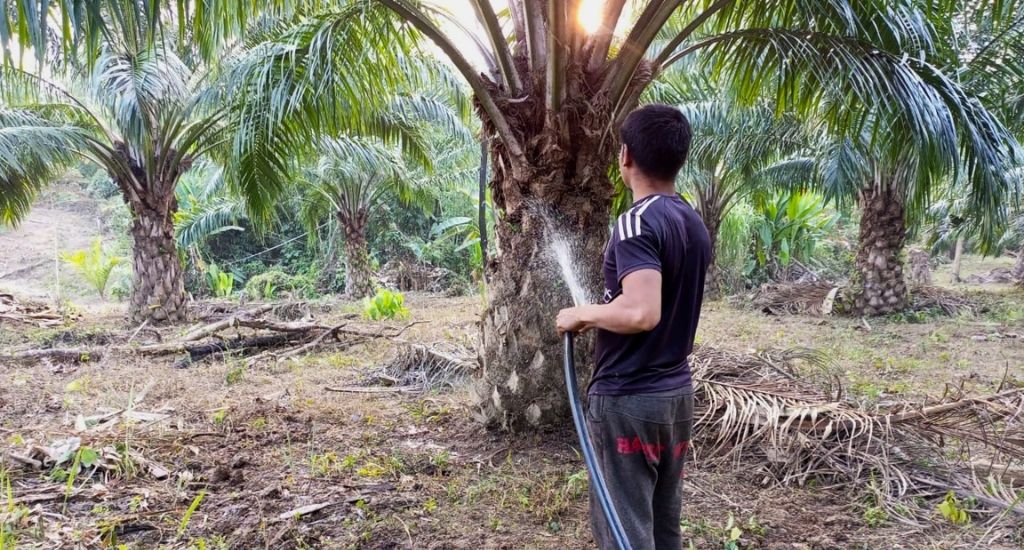On 3rd October 2024, the Union Cabinet chaired by Prime Minister Shri Narendra Modi approved the National Mission on Edible Oils – Oilseeds (NMEO-Oilseeds) to be implemented over a seven-year period from 2024-25 to 2030-31, with a financial outlay of Rs 10,103 crore to boost domestic oilseed production and achieve self-reliance in edible oils. India currently heavily relies on imports and about 57% of its domestic demand for edible oils are imported. Between October 2022 and October 2023, India’s edible oil import bill stood at ₹138,000 crore and three-fifths of the 9.79 million metric tonnes imported was palm oil, mostly from Indonesia and Malaysia. The National Mission targets to increase domestic edible oil production to 25.45 million tonnes by 2030-31 meeting around 72% of India’s projected domestic requirement. In August 2021, the Government of India launched NMEO-OP with a planned outlay of Rs 11,040 crore for raising oil palm area to 10 lakh hectares by 2025-26 and 16.7 lakh hectare by 2029-30 with special focus on North-East and the Andaman and Nicobar Islands.
North East As Focus of India’s Palm Oil Plantation:
The National Mission on Edible Oils-Oil Palm (NMEO-OP) focuses on the North Easter region for palm oil plantation. As per the assessment conducted by the ICAR- Indian Institute of Oil Palm Research (IIOPR) in 2020, out of 27.99 lakh hectares potential area assessed, an area of 18.37 lakh hectares will be from general state and 9.62 lakh hectares in seven NE States. In the North East the coverage was around 38,992 hectares against the potential of 9.62 lakh hectares.
The critical question is from where 9.62 lakh hectares will come from in the North East?
Mizoram, the first State to promote palm oil plantation around 2005-2006 is a burnt out case. The farmers in Mizoram were given the plant and promises of a bright future. Out of the 61,000 hectares (150,000 acres) on which palm oil is grown in the North East, about 67 percent of it are in Mizoram. The palm oil plantation has had a disastrous impact in Mizoram. The plantations deteriorated soil fertility and water availability. Crops were left to rot after harvest due to the lack of infrastructure for transportation and milling. The efforts to replace oil palm with other crops failed due to soil depletion, making farmers the ultimate losers. The companies involved with oil palm plantations in Mizoram — Patanjali’s Ruchi Soya, Godrej and 3F — showed no accountability.
The dream is still being sold!
“By 2024, we have a target to bring 4000 hectares under oil palm cultivation in Rabha Hasong area. Oil palm has replaced rice as the former is much more profitable. On one bigha land (0.13 hectare), farmers growing rice will earn around Rs 4000 in a month. If he grows oil palm on the same land, he will earn three times that amount at the same time.”- stated Mr Tankeswar Rabha, Chief Executive Member of the Rabha Hasong Autonomous Council (RHAC).
The Assam state government itself has promised 3.75 lakh hectares of land to be brought under oil palm cultivation. The Patanjali Food Limited (PFL) has set a target of 60,300-hectare plantation by 2026 in seven districts of Dibrugarh, Tinsukia, Golaghat, Jorhat, Nagaon, Kamrup, Kamrup (Metro) and Goalpara. The PFL promised to set up oil palm processing factories at Dhing and Nagaon.
In November 2023, the tiny State of Tripura set a target of bringing 7000 hectares of land under palm oil cultivation by 2026-27 financial year from 56.35 hectares of land. Godrej Agrovet Ltd and Patanjali Food Ltd already set up nurseries in Nalkata and Jumerdhepa Government Orchard at Dhalai and Sepahijala district respectively. On other hand, the Farmers Welfare Department of Tripura has not been able to organize any training facilities in the field level to train the local cultivators for this work, except for handing over some of the established agri and horti farms of the Tripura government to two Indian multinational companies
Issues of concerns:
A recent study by the Centre for Science and Environment (CSE) predicted that oil palm cultivation could result in the loss of 2.5 million hectares of forest in India by 2030. The study also notes that oil palm plantations store less carbon than natural forests, potentially worsening climate change. There has also been reported increase in human-animal conflict in the Goalpara region of the Rabha Hasong Autonomous Council of Assam where the plantations have been widespread in the state of Assam.
The high usage of groundwater is another worrying factor. Being a water guzzling crop, experts warned that oil palm cultivation could further deplete groundwater in the Northeast. An oil palm plant requires 200 litres of water everyday. The rainfall pattern in the Northeast is already erratic due to climate change impact. Most of the months remained dry whereas huge rainfall is witnessed in two- three months only. Therefore, farmers rely on for borewell irrigation during most part of the year and this will further deplete our groundwater level.
Experts say that oil palm could be worse than jhum cultivation (jungles are slashed and burned for cultivation) practised by tribal farmers on the hills of Northeast. “Forests are regenerated if the land is left for a few years after jhum is practiced. But the same cannot happen after oil palm cultivation. Again, farmers can grow at least 20 different crops in jhum fields but being a monoculture crop, no other crop can be cultivated in the palm oil fields.
In the absence of non-availability of forest land and adequate waste lands, large scale expansion of monoculture crop oil palm is likely to eclipse tropical forests and the rich biodiversity. In addition, the oil palm plantation will create a food crisis for many wildlife species and birds as they don’t eat oil palm fruits.
Lessons from Indonesia:
The oil palm plantations caused massive deforestation in Indonesia accounting for one third (3 million hectares) of Indonesia’s loss of old-growth forest during the first twenty years of this century. This deforestation, alongside peatland drying and associated fires, is an important contributor to global climate change and biodiversity loss, as well as poor local air quality. Every 1,000 tonnes of palm oil produced in 2020 was associated with an average of 3.24 hectares of deforestation risk ranging from zero hectares per 1,000 tonnes for the best performing 10% of production, to 18.2 hectares per 1,000 tonnes for the worst performing 10% of production. As India pushes for the National Mission on Edible Oils – Oilseeds (NMEO-Oilseeds), its consequences are unlikely to be different from Indonesia in the North East.




